On our recent Montana trip I spent two morning sessions with a cooperative Merlin at Red Rock Lakes National Wildlife Refuge in the Centennial Valley.
1/400, f/9, ISO 640, Canon 7D, Canon EF500mm f/4L IS II USM +1.4 tc, not baited, set up or called in
Friday morning as we left camp it was incredibly cold for the first half of September – a couple of minutes before we came across this bird I noticed that it was 11 degrees Fahrenheit (as I mentioned in yesterday’s post, one of the water pipes in my camping trailer was frozen solid that morning – not fun…). Many birds tend to be “stickier” when it’s cold and I’m sure that’s why this Merlin allowed such a close approach (in my pickup along a dirt/gravel road). The sun had just come up so the light was low and the bird had its back to us so at first I didn’t even notice that it had prey.
1/500, f/9, ISO 640, Canon 7D, Canon EF500mm f/4L IS II USM +1.4 tc, not baited, set up or called in
But when it flew to another nearby fence post the prey became obvious – it’s a small bird but I’m not sure of the species.
1/400, f/13, ISO 500, Canon 7D, Canon EF500mm f/4L IS II USM +1.4 tc, not baited, set up or called in
When the Merlin began to feed it quickly became apparent that the prey was frozen solid. I could even hear the soft “clinking” sound of its bill on the frozen flesh. Because the bird was frozen and the sun had just come up I suspect that the prey had been cached the night before (they are known to cache food during the breeding season and in winter).
1/160, f/10, ISO 640, Canon 7D, Canon EF500mm f/4L IS II USM +1.4 tc, not baited, set up or called in
Then, as the Merlin began to feed, almost in an instant we were enveloped by thick fog. The fog in the Centennial Valley is almost mystical – it seems to be alive and is very unpredictable. Less than an hour before sunrise there often is no fog at all but it forms over the lakes very quickly and can be like thick soup when we leave camp at dawn a short while later. If I’d been another 30 feet or so from this bird I’d have barely been able to see it.
1/400, f/7.1, ISO 640, Canon 7D, Canon EF500mm f/4L IS II USM +1.4 tc, not baited, set up or called in
At one point the little falcon picked off a leg…
1/400, f/7.1, ISO 640, Canon 7D, Canon EF500mm f/4L IS II USM +1.4 tc, not baited, set up or called in
but was careful to stash it under one of its toes. A few seconds after this last image was taken I crept forward on the road and left the Merlin to finish its meal.
Photographing this dandy little falcon (they’re only slightly larger than the American Kestrel) on two consecutive mornings was a huge treat for me. I’ve only been able to photograph the species three times before and those previous images leave a lot to be desired. I’ll be posting more images of this bird from the previous morning sometime in the next few weeks.
Ron


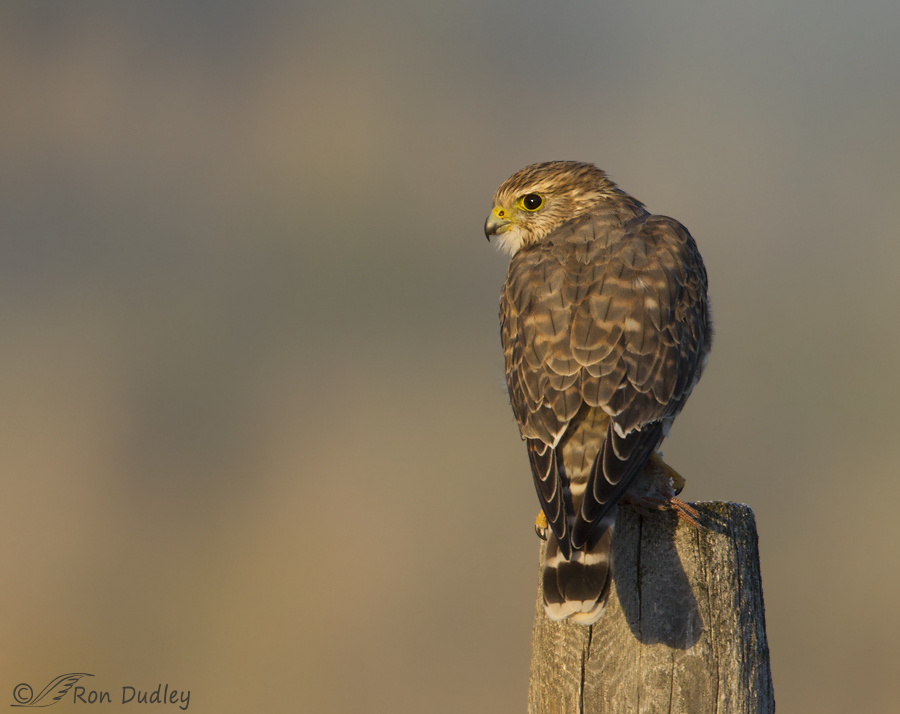
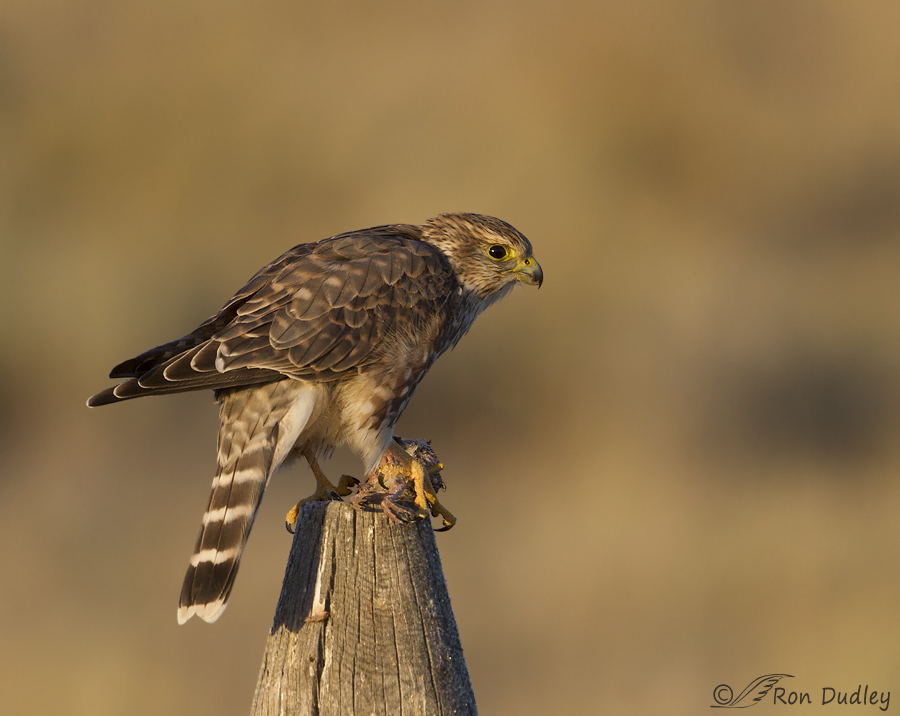
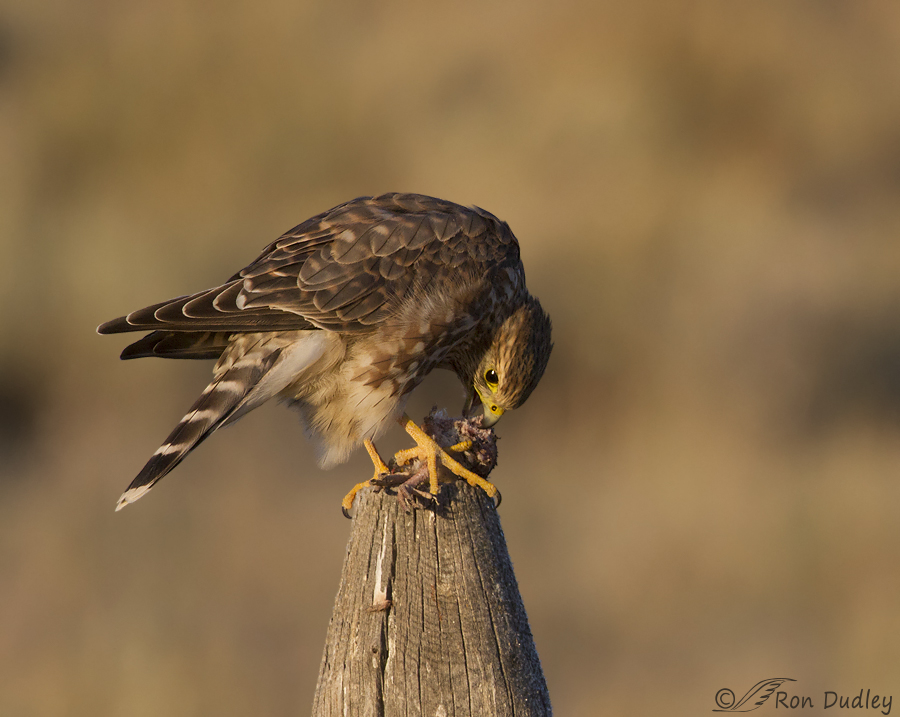
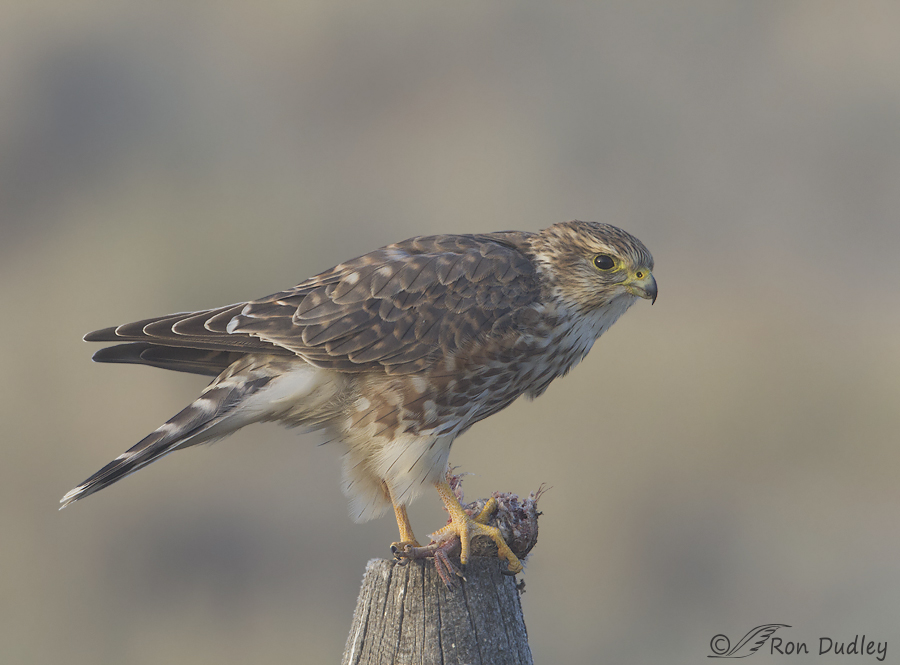
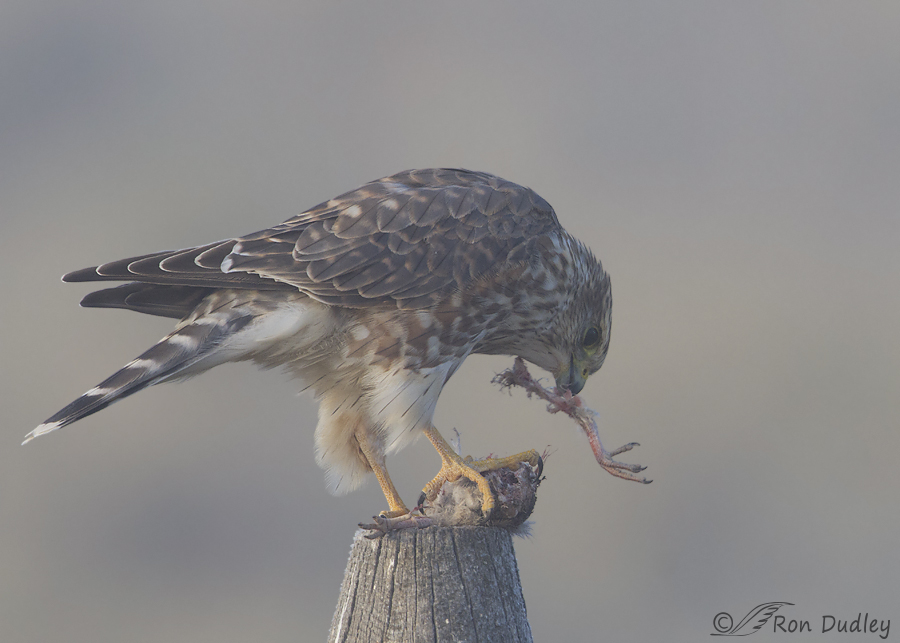
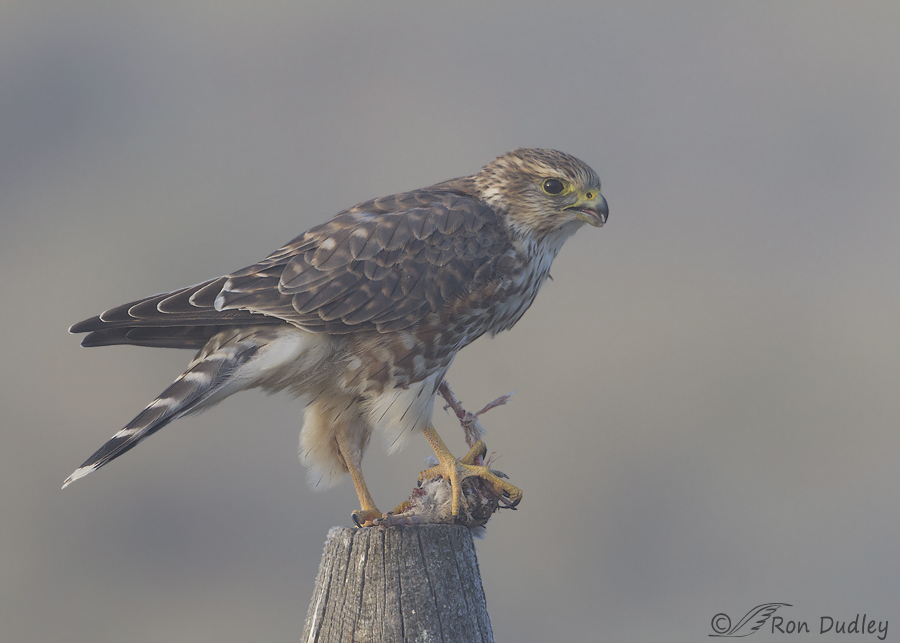
Ron,
I’m really curious about the prey bird. maybe we can figure out what it was.. 1/3 the size of the merlin?
pink/red legs
legs almost as long as the merlin’s
toes[legs] more like a shorebird than a song bird?
what birds were in this habitat that matched some of the prey bird’s fieldmarks?
My curiosity was peeked when I noticed how long the leg was.
Haven’t looked at a field guide for this, but that leg was long compared to what we could imagine to be the size of the bird’s body.
What do you think?
SUE
I’m not sure what to think, Sue. I was curious about what it was too but I’m not terribly strong on details of songbird ID so I didn’t risk a guess and there’s really no shorebirds very close to where these photos were taken. The most common passerines in the area are Horned Larks, Mountain Bluebirds, Western Meadowlarks and a variety of sparrows. If I had to venture a guess I’d probably say meadowlark…
The smaller falcons are my personal favorites. 😀 Love these shots.
Wow! Did your heart rate and blood pressure reach dangerous levels while taking these? Mine probably would have. Your description of the fog reminds me of sailing along the coast of Maine.
That’s EXACTLY what happened, Dave. On that first morning I was so fearful it would fly off before I got close enough and when it didn’t I was very excited!
Ron,
Fantastic photos and great text (yet again!) — and yes, the text really provides much needed context to the photos, I find. The photo with the foot is really quite interesting (in a gruesome sort of way). I have been “sitting” on some photos of a Sharp-shinned Hawk with a Starling for some time, but hesitate to publish them. Unlike your frozen bird, this one was in the clutches of the raptor, but quite alive for several minutes. I only noticed this when I looked at my photos on my home computer.
BTW, I understand what you mean when you say that the bird was not “baited” or “called in”… but what does “set up” mean? I hope I’m not doing this accidentally with my own pics!
Best,
Pierre
I know what you mean, Pierre. I often get shots that might be too “gruesome” for some tastes but I sometimes still post them because I like to document interesting events.
“Setups” are when photographers set up artificial, elaborate and/or attractive perches and then lure the bird in with bait (usually food) or electronic calls. It’s an extremely common practice that I find very distasteful in nature photography. To me it’s akin to studio photography and (IMO) even dishonest when it isn’t disclosed by the photographer (as it usually isn’t).
I see (about setups and the rest). You are quite right: It is dishonest and (if I am wearing my birder’s hat) disruptive to the natural lives of birds, especially raptors.
“It is dishonest and… disruptive to the natural lives of birds, especially raptors.”
Exactly, Pierre! And it’s often done during migration which saps their much-needed energy during that stressful time.
What a privilege for you to see. What a privilege for us to see. Megathanks.
I’m glad you liked the images, Elephant’s Child. Thank you.
Cool. I’ve seen a Cooper’s Hawk feed on a Northern Mockingbird and watched as it consumed it all- including legs/feet.
Thanks, Todd. I’ve seen a variety of raptors do the same, especially during cold weather when food energy is at a premium.
I love love love these pictures
Thank you, Ellen.
Hi! Your shot are really great! Love the photo’s Keep up the great work you do! Have a great day
Thank you, Humming Bird Lover.
Can’t wait for the other photos Ron. Such a neat looking bird. I always love seeing images of raptors with prey.
Thanks, Bryce. I think I remember you saying once that the Merlin was your favorite raptor so I thought of you when I got these shots.
Absolutely gorgeous!!!!! This is an amazing series, of a bird I’ve never had the pleasure of meeting. I’m really glad you had the opportunity to spend significant time with it, and I’m looking forward to seeing more photos.
Thank you, Susan. And a “pleasure” it was, for me to meet this bird also.
Great pictures. The foot shot was a bit unnerving. That foot did not look like it belonged to a small bird. Why did the falcon put the foot under his toes? Great captures, fog and all.
Ellen, it put the foot under the toe so it wouldn’t drop it. I suspect that foot and leg was swallowed too as I’ve seen other raptors do it, though I left this bird before it was through with its meal.
Thanks Ron. I would not have thought this bird would eat the foot. Now I know better. Thanks.
Like Patty, I’m especially struck by the third photo. I’m personally moved by both the beautiful curve of the spine and the exquisite fan of soft feathers below. Thanks for not only making these rare views of a bird’s life clear, but also for sharing how it feels to be so focused in the moment, on site in the 11ºF morning with the mystical fog rolling in, hearing the ‘clink’ of the beak on frozen food.
I appreciate your feedback on the background info I provide, Alison. Sometimes I don’t know if I should include stuff like that or not…
It’s a huge treat for us all Ron! What fantastic shots! Thanks so much for sharing!
Charlotte
Thanks very much, Charlotte.
These are beautiful images…so lucky to have had the chance to get them…especially like the third with the pose, weathered wood and foggy background…must have been hard to leave…
It was hard to leave, Patty – always is. But I was out of clean clothes, propane and food was running low and after 6 days it was time…